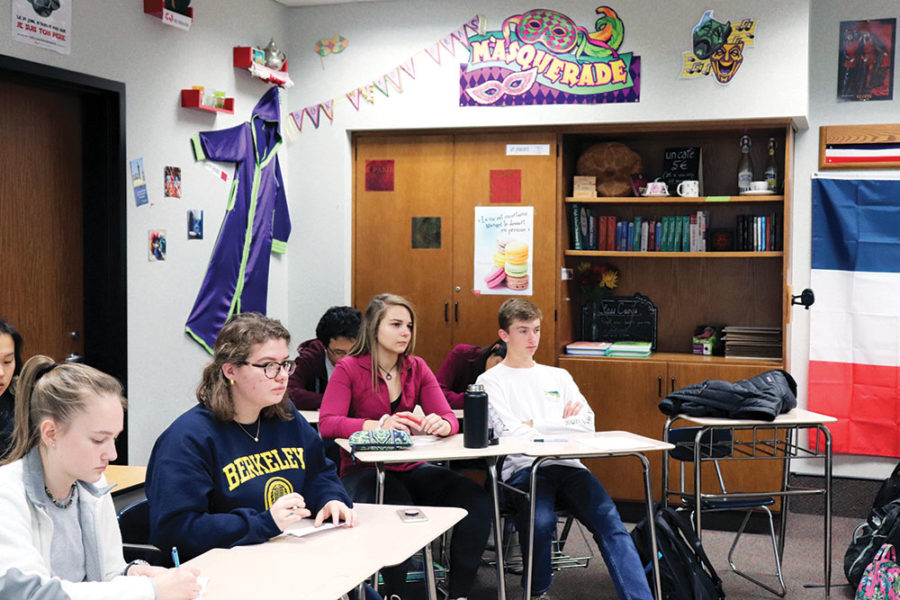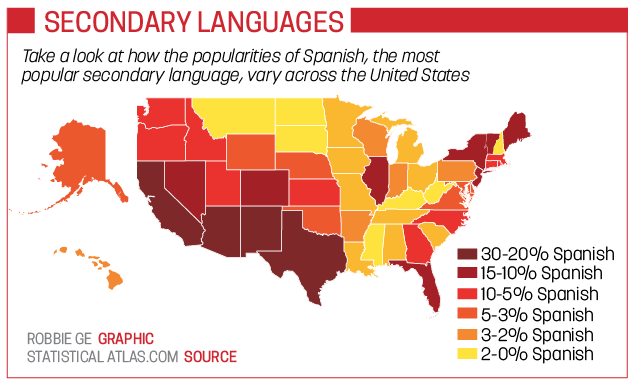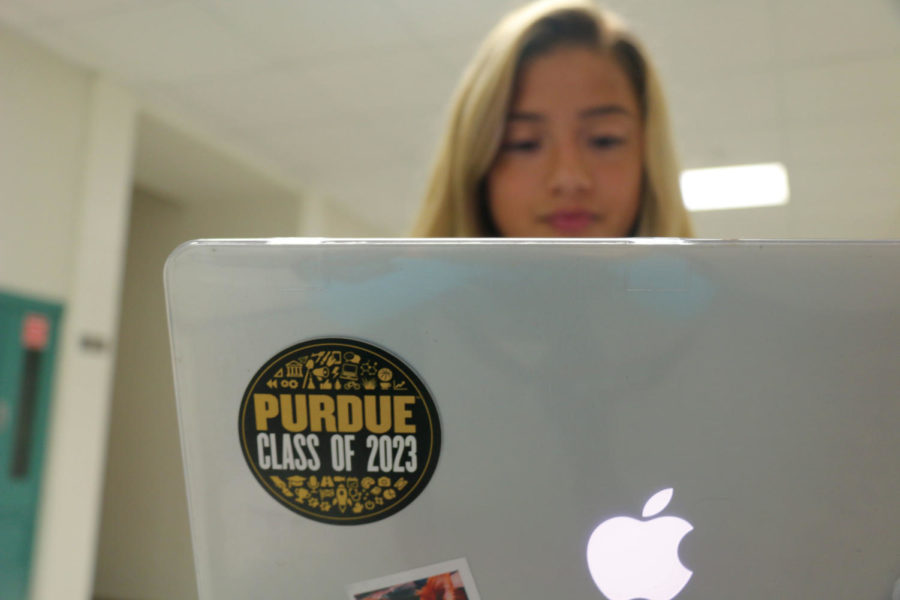Junior Ava Hutchison walks down the hall with purpose, but stops when she sees someone who is familiar to her, her French II teacher, Kim Manlick. Although she was planning to go class early to study, she still stops to say “Bonjour.” For Hutchison, although France has always been a passion of hers, she said she really only started to love its language when she had Manlick as a teacher her freshman year. Now, Hutchison said she works ahead of her peers in class and also takes opportunities outside of school, like the Indiana University Program in Foreign Languages (IUHPFL) program, in order to achieve fluency.

Because of her passion, Hutchison said she feels she is close to fluency in her chosen foreign language, something she feels other students in Carmel or even in the United States never achieve.
She said, “I personally think that (achieving fluency) is dependent on the curriculum utilized by the school. I think for the most part, it is subpar (for most schools in the United States). (Schools in the United States) don’t prepare you for fluency as well as they should or as well as other nations do.”
A recent study from Pew Research Center, a nonpartisan think tank in the United States, affirms what Hutchison said. In the study, it stated only 25 percent of U.S. adults said they spoke a language other than English, and that of that 25 percent, only 7 percent said they acquired their ability at school.
Junior Ellie Dyas said because of her experiences studying abroad she feels the idea that both Hutchison and the Pew Research Center study presented are accurate.
She said, “My host sister, when I was in Austria this summer, studies foreign languages. She is basically fluent in French, German and English. She is also studying Latin and Greek. (Europeans) value (languages) more. She has just worked on it since she was in kindergarten. Now, she is much better at it than I am.”
Andrea Yocum, world language department chairperson and French teacher, said she attributes much of the success of other nations in achieving fluency to the fact that languages are taught at an earlier age.
Yocum said, “The difference with American schools is in a lot of European schools you have kids that are going to start their language in, say, fourth grade. For instance, French schools start in sixth grade and language is mandatory. They take multiple languages. They also have what is called dual-language immersion programs where (…) for example, your math class is in Spanish or your science class is in Spanish. You might not go home and speak the language with your family, but you get a lot more out of access to it at school and a lot more occasion to use it.”

In Hutchison’s case, she said she agreed age helps achieve fluency but also said it works in tandem with the proliferation of English media.
She said, “Frankly, the predominance of American and English language media in the world is incredible. It is very easy to obtain fluency in a country where the native tongue is not English. The best TV shows, the best music and the best movies are all produced in English. (European) students have been introduced to the languages that they would be taking far earlier than they would actually start the class.”
Despite the relatively low rate of fluency from high school foreign language classes, Yocum said she feels Carmel is set apart from the rest of the nation because of its multicultural society.
She said, “If there’s, say, 30 students in the room, usually at least five or six of them already speak another language than the language that they’re studying. I think we’re very lucky to have that. It’s strength in diversity. People are also able to apply patterns because of their home language skills.”
Hutchison similarly said that CHS has a higher rate of fluency because of its multicultural and multilingual society.
She said, “I do think that (Carmel) has a large multicultural, multilingual community. I think that is a very nice privilege that the students at CHS are able to take advantage of and experience. I do think that a lot of the bilingualism or often trilingualism are not offered by opportunities or the department, though it is great. They are often offered just by the pure multiculturalism of our community, that languages are taught at home with families, and kids come to school and learn English through the American community.”
Although most U.S. schools only offer the opportunity for students to take one foreign language, if any at all, according to a recent study from Pew Research Center, “Studying a second foreign language for at least one year is compulsory in more than 20 European countries.”

Dyas said, “I don’t know if it should change (the system to require more than one language), but I do know that it is a very useful program for (European students). I think that we should make it an achievable goal in this school system. I know that right now, here at a Carmel, there is no way that you can take three languages and graduate, so we could definitely offer it as an option. But, I don’t know if we should require it or if it’s really necessary for us.”
Like Dyas, Hutchison said she believes high schools in the United States shouldn’t necessarily implement the system of offering multiple languages simultaneously.
She said, “(The lack of multiple-language learning) is a result of the dominance of the three most spoken languages in the world, which happen to be English, Arabic and Chinese. I know that (learning multiple languages) is not a priority of our schools in terms of languages because I know that we, as Americans, feel comfortable that we can travel internationally and find people that speak our language. This isn’t the truth for many of the nations that do require their students to take more than one language.”
Yocum said she also agreed with the idea that the dominance of English leads to the U.S. students only learning one foreign language during high school.
Yocum said, “I think that economically we have been strong for quite a while and that strength has caused people around the world to learn English to accommodate us. I think in an ideal world, Americans would also equally value other languages as much as other cultures value our input and learn English. I think (a global mentality) is something that you have to be deliberate about marketing or selling to people because there are a lot of people in America who think that English is a strong enough language that they really don’t need to have fluency in other languages.”



















![Joseph Broman, Mu Alpha Theta sponsor, grades tests for his honors precalculus/trigonometry class. Broman said, “I’m retiring from the Math Club next year and I’m just going to do Mu Alpha Theta so I can focus on that one and we can do more [speaker series] first semester.”](https://hilite.org/wp-content/uploads/2024/03/IMG_9502-1200x900.jpg)










![British royalty are American celebrities [opinion]](https://hilite.org/wp-content/uploads/2024/03/Screenshot-2024-03-24-1.44.57-PM.png)


![The new “Kung Fu Panda 4” movie: a journey of growth, self-realization and adventure [opinion]](https://hilite.org/wp-content/uploads/2024/03/po-1200x588.png)


















![Review: “The Bear” sets an unbelievably high bar for future comedy shows [MUSE]](https://hilite.org/wp-content/uploads/2024/03/unnamed.png)
![Review: “Mysterious Lotus Casebook” is an amazing historical Chinese drama [MUSE]](https://hilite.org/wp-content/uploads/2024/03/0.webp)
![Thea Bendaly on her Instagram-run crochet shop [Biz Buzz]](https://hilite.org/wp-content/uploads/2024/03/IMG_0165-1200x838.jpg)
![Review: Sally Rooney’s “Normal People,” is the best book to read when you are in a time of change [MUSE]](https://hilite.org/wp-content/uploads/2024/03/20047217-low_res-normal-people.webp)
![Review: “One Day” broke me for the second time, but this time it hurt worse [MUSE]](https://hilite.org/wp-content/uploads/2024/03/unnamed-8.png)
![Review in Print: Maripaz Villar brings a delightfully unique style to the world of WEBTOON [MUSE]](https://hilite.org/wp-content/uploads/2023/12/maripazcover-1200x960.jpg)
![Review: “The Sword of Kaigen” is a masterpiece [MUSE]](https://hilite.org/wp-content/uploads/2023/11/Screenshot-2023-11-26-201051.png)
![Review: Gateron Oil Kings, great linear switches, okay price [MUSE]](https://hilite.org/wp-content/uploads/2023/11/Screenshot-2023-11-26-200553.png)
![Review: “A Haunting in Venice” is a significant improvement from other Agatha Christie adaptations [MUSE]](https://hilite.org/wp-content/uploads/2023/11/e7ee2938a6d422669771bce6d8088521.jpg)
![Review: A Thanksgiving story from elementary school, still just as interesting [MUSE]](https://hilite.org/wp-content/uploads/2023/11/Screenshot-2023-11-26-195514-987x1200.png)
![Review: When I Fly Towards You, cute, uplifting youth drama [MUSE]](https://hilite.org/wp-content/uploads/2023/09/When-I-Fly-Towards-You-Chinese-drama.png)
![Postcards from Muse: Hawaii Travel Diary [MUSE]](https://hilite.org/wp-content/uploads/2023/09/My-project-1-1200x1200.jpg)
![Review: Ladybug & Cat Noir: The Movie, departure from original show [MUSE]](https://hilite.org/wp-content/uploads/2023/09/Ladybug__Cat_Noir_-_The_Movie_poster.jpg)
![Review in Print: Hidden Love is the cute, uplifting drama everyone needs [MUSE]](https://hilite.org/wp-content/uploads/2023/09/hiddenlovecover-e1693597208225-1030x1200.png)
![Review in Print: Heartstopper is the heartwarming queer romance we all need [MUSE]](https://hilite.org/wp-content/uploads/2023/08/museheartstoppercover-1200x654.png)













![Review: Ladybug & Cat Noir: The Movie, departure from original show [MUSE]](https://hilite.org/wp-content/uploads/2023/09/Ladybug__Cat_Noir_-_The_Movie_poster-221x300.jpg)

![Review: Next in Fashion season two survives changes, becomes a valuable pop culture artifact [MUSE]](https://hilite.org/wp-content/uploads/2023/03/Screen-Shot-2023-03-09-at-11.05.05-AM-300x214.png)
![Review: Is The Stormlight Archive worth it? [MUSE]](https://hilite.org/wp-content/uploads/2023/10/unnamed-1-184x300.png)






